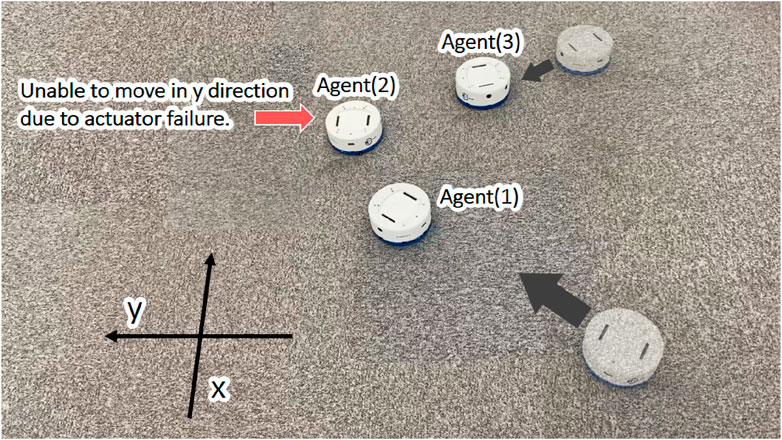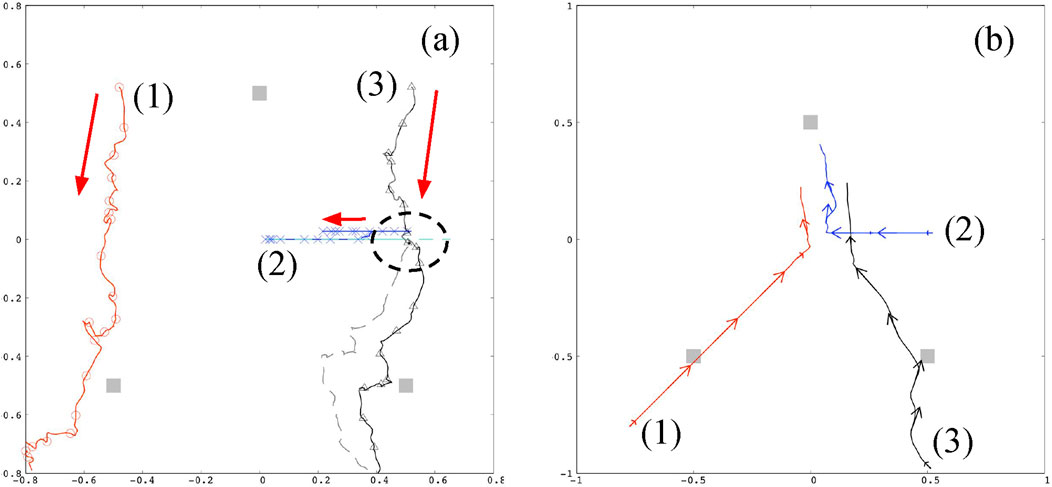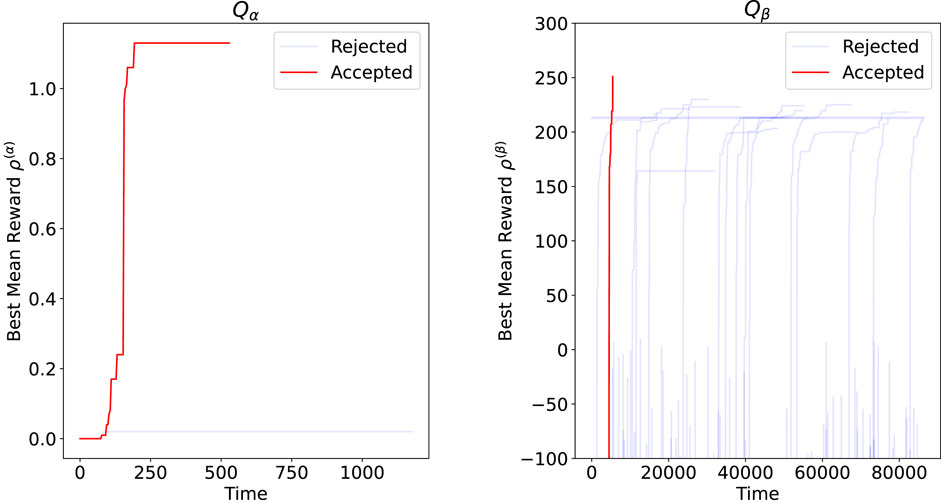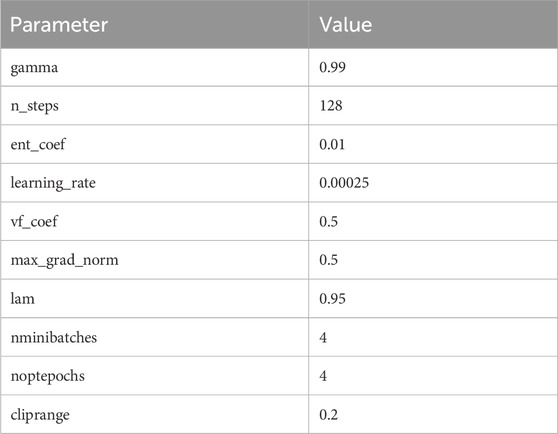- 1School of Materials Science, Japan Advanced Institute of Science and Technology (JAIST), Nomi, Ishikawa, Japan
- 2School of Information Science, Japan Advanced Institute of Science and Technology (JAIST), Nomi, Ishikawa, Japan
- 3Air Force Research Laboratory, Wright Patterson Air Force Base, Dayton, OH, United States
- 4Research Center for Advanced Computing Infrastructure, Japan Advanced Institute of Science and Technology (JAIST), Nomi, Ishikawa, Japan
When deploying agents to execute a mission with collective behavior, it is common for accidental malfunctions to occur in some agents. It is challenging to distinguish whether these malfunctions are due to actuator failures or sensor issues based solely on interactions with the affected agent. However, we humans know that if we cause a group behavior where other agents collide with a suspected malfunctioning agent, we can monitor the presence or absence of a positional change and identify whether it is the actuator (position changed) or the sensor (position unchanged) that is broken. We have developed artificial intelligence that can autonomously deploy such “information acquisition strategies through collective behavior” using machine learning. In such problems, the goal is to plan collective actions that result in differences between the hypotheses for the state [e.g., actuator or sensor]. Only a few of the possible collective behavior patterns will lead to distinguishing between hypotheses. The evaluation function to maximize the difference between hypotheses is therefore sparse, with mostly flat values across most of the domain. Gradient-based optimization methods are ineffective for this, and reinforcement learning becomes a viable alternative. By handling this maximization problem, our reinforcement learning surprisingly gets the optimal solution, resulting in collective actions that involve collisions to differentiate the causes. Subsequent collective behaviors, reflecting this situation awareness, seemed to involve other agents assisting the malfunctioning agent.
1 Problem formulation
The group cooperation of agents is an important topic studied in the context of autonomous systems (Lee et al., 2018; Hu et al., 2020). Because it is likely that each agent will have individual biases in its actuator or sensor performance, it is an important autonomous ability to analyze these inherent biases and revise the control plan appropriately to continue the group mission. Such biases dynamically change over time during missions, occasionally leading to failures in some functions of an agent. When such changes occur, it is essential to promptly revise the transportation plan using methods such as reinforcement learning. However, this requires constructing a virtual environment that accurately reflects real-world conditions. Therefore, to properly update the operational plan using reinforcement learning, it is necessary to identify the causes of the biases, including any failures, in each agent as they occur.
Previous research on fault diagnosis methods in swarm robotic systems includes the work by O'Keeffe et al. (O’Keeffe et al., 2018). This approach adopts a fault diagnosis mechanism, inspired by biological immune systems, that learns from past diagnostic results to efficiently identify malfunctions based on the behavior of robots. However, the diagnostic tests assumed here only target predictable faults and may struggle when multiple faults occur simultaneously. This difficulty in diagnosis is an inevitable challenge in the advancement of robotic development.
One of the factors complicating this diagnosis is the difficulty in distinguishing the causes of faults.
Suppose that a command base, which controls a group of agents via each command

Figure 1. Agents perform group actions according to commands communicated from the “control base” (the figure depicts an example with three agents indexed by
Such autonomous planning appears to be feasible given the following value function. Suppose that the command
However, this maximization task is difficult to complete via conventional gradient-based optimization. Owing to the wide range of possibilities for
Reinforcement learning (Nachum et al., 2018; Sutton and Barto, 2018; Barto, 2002) is becoming an established field in the wider context of robotics and system controls (Peng et al., 2018; Finn and Levine (2017). Methodological improvements have been studied intensively, especially by verifications on gaming platforms (Mnih et al., 2015; Silver et al., 2017; Vinyals et al., 2019). Thus, the topic addressed in this study is becoming a subfield known as multi-agent reinforcement learning (MARL) (Busoniu et al., 2006; Gupta et al., 2017; Straub et al., 2020; Bihl et al., 2022; Gronauer and Diepold, 2021). Specific examples of multi-agent missions include unmanned aerial vehicles (UAV) (Bihl et al., 2022; Straub et al., 2020) and sensor resource management (SRM) Malhotra et al., 2017, 1997; Hero and Cochran, 2011; Bihl et al., 2022). The objective of this study can also be regarded as the problem of handling non-stationary environments in multi-agent reinforcement learning (Nguyen et al., 2020; Foerster et al., 2017). As a consequence of failure, agents are vulnerable to the gradual loss of homogeneity. Prior studies have addressed the problem of heterogeneity in multi-agent reinforcement learning (Busoniu et al., 2006; Calvo and Dusparic, 2018; Bihl et al., 2022; Straub et al., 2020; Gronauer and Diepold, 2021). The problem of sparse rewards has also been recognized and discussed as one of the current challenges in reinforcement learning (Wang and Taylor, 2017; Bihl et al., 2022). Recent advancements in reinforcement learning have introduced various innovative methods for handling single-agent or multi-agent scenarios. These approaches have focused on improving sample efficiency, computational costs, and learning stability across different frameworks. One such method is TD7, which utilizes state-action learned embeddings (SALE) for jointly learning embeddings of both states and actions Fujimoto et al., 2024). CrossQ is another approach that improves sample efficiency while significantly reducing computational costs by utilizing batch normalization (Bhatt et al., 2019). Continuous dynamic policy programming (CDPP) extends relative entropy regularized reinforcement learning from value function-based frameworks to actor-critic structures in continuous action spaces, achieving improved sample efficiency and learning stability (Shang et al., 2023). Furthermore, dropout Q-functions (DroQ) employs a small ensemble of dropout Q-functions to enhance computational efficiency while maintaining sample efficiency comparable to randomized ensembled double Q-learning (REDQ) (Hiraoka et al., 2021). In the realm of multi-agent reinforcement learning, multi-agent continuous dynamic policy gradient (MACDPP) has achieved high learning capability and sample efficiency by introducing relative entropy regularization to the centralized training with decentralized execution (CTDE) framework Miao et al., 2024).
The discussion thus far can be generalized as follows: Consider a scenario involving
As a prototype of such a problem, we considered a system composed of three agents moving on an

Figure 2. View of actual machines labeled as Agents #1–#3. Agent #2 is unable to move in the y-direction due to actuator failure. Agents #1 and #3 are on their way to rescue Agent#2 (see the main text about how the AI determines the action plan for the recovery of Agent #2).
Remarkably, the optimal action plan generated by reinforcement learning showed a human-like solution to pinpoint the problem by colliding other agents with the failed agent. By inducing a collision, the base could identify that #2 is experiencing problems with its actuators rather than sensors. The base then starts planning group motions to complete the conveying task, considering the limited functionality of #2. We observe that the cooperative tasks are facilitated by a learning process wherein other agents appear to compensate for the deficiency of #2 by pushing it toward the goal. In the present study, we employed a simple prototype system to demonstrate that reinforcement learning is extremely effective in setting up a verification plan that pinpoints multiple hypotheses for general cases of system failure.
2 Methodology
Let the state space for the agents be
The difference
can then be the measure to evaluate performance and thereby distinguish between the hypotheses. Therefore, the best operation plan for the distinction should be determined as
The naive idea of performing optimization using gradient-based methods is insufficient, owing to the sparseness described in the introduction. For
Suppose we can evaluate the reward
3 Experiments
The workflow required to achieve the mission for the agents, as described in §1, proceeds as follows:
[0a ] To determine if there are errors found in any of the agents, the base issues commands to move all agents by tiny displacements (and consequently, Agent #2 is found to have an error).
[0b ] Corresponding to each possible hypothesis (
[1 ] Reinforcement learning
[2 ] The plan
[3 ] By taking the virtual space
[4 ] Agents are operated according to the plan
In this context, the term “virtual space” refers to an environment where physical computations are performed to simulate the movements of agents. In this study, it was implemented using Python. All learning processes and operations are simulated on a Linux server. The learning phase is the most time-intensive, requiring approximately 3 h to complete using a single processor without any parallelization. For the learning phase, we implemented the PPO2 (proximal policy optimization, version 2) algorithm Schulman et al., 2015) from the OpenAI Gym Brockman et al., 2016) library. Reinforcement learning
The learning process
Each
Taking the value function,
the two-fold
Denoting the converged table as
The operation sequence generates the two-fold sequence of (virtual) state evolutions as
as shown in Figure 3A.

Figure 3. Agent trajectories are driven by each operation plan consequently generated via reinforcement learning (with the MLP neural network structure),
In Step [2], the agents operate according to the plan expressed by Equation 3 to update (real) states as
to be observed by the command base. The base compares Equations 4, 5 to identify whether
In Step [3],
by which the states of the agents are updated as
as shown in Figure 3B.
4 Discussion
Figure 3A depicts two-fold trajectories, Equation 4, corresponding to the hypotheses
Three square symbols (closed) situated at the edges of a triangle in Figure 3 represent the goalposts for the conveying mission. Figure 3B shows the real trajectories for the mission, where the initial locations of the agents are the final locations in the panel (a). From their initial locations, Agents #1 and #3 immediately arrived at their goals to complete each mission and subsequently headed to Agent #2 for assistance. Meanwhile, Agent #2 attempted to reach its goal using its limited mobility; that is, only along the
During training, if the target reward is not reached in the given number of training sessions, the training process is reset to avoid being trapped by the local solution. In Figure 4, the training curves of rejected trials are shown in blue, whereas the acceptable result is shown in red. Evidently, more learning processes were rejected in

Figure 4. Learning curve evaluated for MLP network construction in terms of the reward function. Results for
The performance of LSTM and MLP was compared in terms of the success rate for obtaining working trajectories to distinguish between the hypotheses. Notably, even when applying the well-converged
For a simulation in a virtual environment space, we must evaluate the distances between agents at every step. As this is a pairwise evaluation, its computational cost scales as
5 Conclusion
Agents performing group missions can suffer from errors during missions. Multiple hypotheses may be devised to explain the causes of such errors. Cooperative behaviors, such as collisions between agents, can be deployed to identify said causes. We considered the autonomous planning of group behaviors via machine-learning techniques. Different hypotheses explaining the causes of the errors lead to different expected states as updated from the same initial state by the same operation. The larger the difference becomes, the better the corresponding operation plan can distinguish between the different hypotheses. In other words, the magnitude of the difference can be the value function to optimize the desired operation plan. Gradient-based optimization does not work well because a tiny fraction among the vast possible operations (e.g., collisions) can capture the difference, leading to a sparse distribution of the finite value for the function. We discovered that reinforcement learning is the obvious choice for such problems. Notably, the optimal plan obtained via reinforcement learning was the operation that causes agents to collide with each other. To identify the causes of error using this plan, we developed a revised mission plan that incorporates the failure of another learning where the malfunctioning agent receives assistance from other agents. By identifying the cause of failure, the reinforcement learning process plans a revised mission plan that considers said failure to ensure an appropriate cooperation procedure. In this study, we conducted tests under the significant constraint that one of the three agents was malfunctioning. As described in §1, the framework can generally be formulated for
Data availability statement
The raw data supporting the conclusions of this article will be made available by the authors, without undue reservation.
Author contributions
KU: conceptualization, methodology, validation, and writing–review and editing. K-tH: data curation, visualization, and writing–review and editing. TB: validation and writing–review and editing. KH: writing–review and editing. RM: funding acquisition, supervision, and writing–original draft.
Funding
The author(s) declare that financial support was received for the research, authorship, and/or publication of this article. This work was supported by MEXT-KAKENHI (19H04692 and 16KK0097) and the Air Force Office of Scientific Research (AFOSR-AOARD/FA2386-17-1-4049; FA2386-19-1-4015).
Acknowledgments
The computations in this work were performed using the facilities at the Research Center for Advanced Computing Infrastructure at JAIST. RM is grateful for financial support from MEXT-KAKENHI (19H04692 and 16KK0097) and from the Air Force Office of Scientific Research (AFOSR-AOARD/FA2386-17-1-4049; FA2386-19-1-4015). The authors would like to thank Kosuke Nakano for his feedback as it significantly helped improve the overall paper. This work was cleared for public release under case AFRL-2023-3698. This work is the work of the authors and does not reflect any opinion or position of the U.S. government, the U.S. Air Force, or the Air Force Research Laboratory.
Conflict of interest
The authors declare that the research was conducted in the absence of any commercial or financial relationships that could be construed as a potential conflict of interest.
Publisher’s note
All claims expressed in this article are solely those of the authors and do not necessarily represent those of their affiliated organizations, or those of the publisher, the editors, and the reviewers. Any product that may be evaluated in this article, or claim that may be made by its manufacturer, is not guaranteed or endorsed by the publisher.
Supplementary material
The Supplementary Material for this article can be found online at: https://www.frontiersin.org/articles/10.3389/fcteg.2024.1402621/full#supplementary-material
References
Barto, A. G. (2002). “Innovation and intellectual property rights,” in The handbook of brain theory and neural networks. Editor M. A. Arbib Second Edition (Cambridge, MA: The MIT Press), 963–972.
Bhatt, A., Palenicek, D., Belousov, B., Argus, M., Amiranashvili, A., Brox, T., et al. (2019). Crossq: batch normalization in deep reinforcement learning for greater sample efficiency and simplicity. arXiv preprint arXiv:1902.05605
Bihl, T., Jones, A., Farr, P., Straub, K., Bontempo, B., and Jones, F. (2022). “Assessing multi-agent reinforcement learning algorithms for autonomous sensor resource management,” in Proceedings of the 55th Hawaii international Conference on system Sciences (Hawaii international conference on system Sciences) (Honolulu, USA: HICSS). doi:10.24251/hicss.2022.695
Bihl, T. J., Schoenbeck, J., Steeneck, D., and Jordan, J. (2020). “Easy and efficient hyperparameter optimization to address some artificial intelligence “ilities”,” in 53rd Hawaii international conference on system Sciences, HICSS 2020, maui, Hawaii, USA, january 7-10, 2020 ScholarSpace, 1–10.
Brockman, G., Cheung, V., Pettersson, L., Schneider, J., Schulman, J., Tang, J., et al. (2016). Openai gym
Busoniu, L., Babuska, R., and De Schutter, B. (2006). “Multi-agent reinforcement learning: a survey,” in 2006 9th international conference on control, automation, robotics and vision, 1–6. doi:10.1109/ICARCV.2006.345353
Calvo, J., and Dusparic, I. (2018). Heterogeneous multi-agent deep reinforcement learning for traffic lights control. Proc. 26th Ir. Conf. Artif. Intell. Cogn. Sci., 1–12.
Domhan, T., Springenberg, J. T., and Hutter, F. (2015). “Speeding up automatic hyperparameter optimization of deep neural networks by extrapolation of learning curves,” in Proceedings of the 24th international conference on artificial intelligence, 3460–3468.
Finn, C., and Levine, S. (2017). “Deep visual foresight for planning robot motion,” in 2017 IEEE international conference on robotics and automation (ICRA), 2786–2793. doi:10.1109/ICRA.2017.7989324
Foerster, J., Nardelli, N., Farquhar, G., Afouras, T., Torr, P. H. S., Kohli, P., et al. (2017). “Stabilising experience replay for deep multi-agent reinforcement learning,” in Proceedings of the 34th international conference on machine learning. (PMLR), vol. 70 of Proceedings of machine learning research. Editors D. Precup, and Y. W. Teh, 1146–1155.
Friston, K. (2010). The free-energy principle: a unified brain theory? Nat. Rev. Neurosci. 11, 127–138. doi:10.1038/nrn2787
Fujimoto, S., Chang, W.-D., Smith, E., Gu, S. S., Precup, D., and Meger, D. (2024). For sale: state-action representation learning for deep reinforcement learning. Adv. Neural Inf. Process. Syst. 36.
Gronauer, S., and Diepold, K. (2021). Multi-agent deep reinforcement learning: a survey. Artif. Intell. Rev. 55, 895–943. doi:10.1007/s10462-021-09996-w
Gupta, J. K., Egorov, M., and Kochenderfer, M. (2017). “Cooperative multi-agent control using deep reinforcement learning,” in Autonomous agents and multiagent systems. Editors G. Sukthankar, and J. A. Rodriguez-Aguilar (Cham: Springer International Publishing), 66–83.
Hayaschi, K. (2024). Video for fig. 3. Available at: https://www.dropbox.com/s/feejhj389h7p215/robot2_labeled.mp4?dl=0.
Henderson, P., Islam, R., Bachman, P., Pineau, J., Precup, D., and Meger, D. (2018). “Deep reinforcement learning that matters,” in Aaai.
Hero, A. O., and Cochran, D. (2011). Sensor management: past, present, and future. IEEE Sensors J. 11, 3064–3075. doi:10.1109/JSEN.2011.2167964
Hiraoka, T., Imagawa, T., Hashimoto, T., Onishi, T., and Tsuruoka, Y. (2021). Dropout q-functions for doubly efficient reinforcement learning. arXiv Prepr. arXiv:2110.02034.
Hu, J., Niu, H., Carrasco, J., Lennox, B., and Arvin, F. (2020). Voronoi-based multi-robot autonomous exploration in unknown environments via deep reinforcement learning. IEEE Trans. Veh. Technol. 69, 14413–14423. doi:10.1109/TVT.2020.3034800
Huang, B.-Q., Cao, G.-Y., and Guo, M. (2005). Reinforcement learning neural network to the problem of autonomous mobile robot obstacle avoidance. 2005 Int. Conf. Mach. Learn. Cybern. 1, 85–89. doi:10.1109/ICMLC.2005.1526924
Lee, H., Kim, H., and Kim, H. J. (2018). Planning and control for collision-free cooperative aerial transportation. IEEE Trans. Automation Sci. Eng. 15, 189–201. doi:10.1109/TASE.2016.2605707
Malhotra, R., Blasch, E., and Johnson, J. (1997). Learning sensor-detection policies. Proc. IEEE 1997 Natl. Aerosp. Electron. Conf. NAECON 1997 2, 769–776. doi:10.1109/NAECON.1997.622727
Malhotra, R. P., Pribilski, M. J., Toole, P. A., and Agate, C. (2017). “Decentralized asset management for collaborative sensing,” in Micro- and nanotechnology sensors, systems. Editors I. X. Applications, T. George, A. K. Dutta, and M. S. Islam (SPIE: International Society for Optics and Photonics), 10194, 403–414.
Miao, C., Cui, Y., Li, H., and Wu, X. (2024). Effective multi-agent deep reinforcement learning control with relative entropy regularization. IEEE Trans. Automation Sci. Eng., 1–15doi. doi:10.1109/TASE.2024.3398712
Mnih, V., Kavukcuoglu, K., Silver, D., Rusu, A. A., Veness, J., Bellemare, M. G., et al. (2015). Human-level control through deep reinforcement learning. Nature 518, 529–533. doi:10.1038/nature14236
Nachum, O., Gu, S., Lee, H., and Levine, S. (2018). “Data-efficient hierarchical reinforcement learning,” in Proceedings of the 32nd international conference on neural information processing systems, 3307–3317.
Nguyen, T. T., Nguyen, N. D., and Nahavandi, S. (2020). Deep reinforcement learning for multiagent systems: a review of challenges, solutions, and applications. IEEE Trans. Cybern. 50, 3826–3839. doi:10.1109/TCYB.2020.2977374
O’Keeffe, J., Tarapore, D., Millard, A. G., and Timmis, J. (2018). Adaptive online fault diagnosis in autonomous robot swarms. Front. Robotics AI 5, 131. doi:10.3389/frobt.2018.00131
Peng, X. B., Andrychowicz, M., Zaremba, W., and Abbeel, P. (2018). “Sim-to-real transfer of robotic control with dynamics randomization,” in 2018 IEEE international conference on robotics and automation (ICRA), 3803–3810. doi:10.1109/ICRA.2018.8460528
Schulman, J., Levine, S., Mortiz, P., Jordan, M., and Abbeel, P. (2015). Trust region policy optimization. Proc. 32nd Int. Conf. Mach. Learn. 37, 1889–1897.
Shang, Z., Li, R., Zheng, C., Li, H., and Cui, Y. (2023). Relative entropy regularized sample-efficient reinforcement learning with continuous actions. IEEE Trans. Neural Netw. Learn. Syst., 1–11doi. doi:10.1109/TNNLS.2023.3329513
Silver, D., Schrittwieser, J., Simonyan, K., Antonoglou, I., Huang, A., Guez, A., et al. (2017). Mastering the game of go without human knowledge. Nature 550, 354–359. doi:10.1038/nature24270
Snoek, J., Larochelle, H., and Adams, R. P. (2012). Practical bayesian optimization of machine learning algorithms. Proc. 25th Int. Conf. Neural Inf. Process. Syst. - 2, 2951–2959.
Straub, K. M., Bontempo, B., Jones, F., Jones, A. M., Farr, P., and Bihl, T. (2020). Sensor resource management using multi-agent reinforcement learning with hyperparameter optimization. Tech. Rep. White paper.
Sutton, R. S., and Barto, A. G. (2018). Reinforcement learning: an introduction. second edn. The MIT Press.
Vinyals, O., Babuschkin, I., Czarnecki, W. M., Mathieu, M., Dudzik, A., Chung, J., et al. (2019). Grandmaster level in starcraft ii using multi-agent reinforcement learning. Nature 575, 350–354. doi:10.1038/s41586-019-1724-z
Wang, Z., and Taylor, M. E. (2017). “Improving reinforcement learning with confidence-based demonstrations,” in Proceedings of the twenty-sixth international joint conference on artificial intelligence (Darmstadt, Germany: IJCAI-17), 3027–3033. doi:10.24963/ijcai.2017/422
Xia, C., and El Kamel, A. (2016). Neural inverse reinforcement learning in autonomous navigation. Robotics Aut. Syst. 84, 1–14. doi:10.1016/j.robot.2016.06.003
Young, M. T., Hinkle, J. D., Kannan, R., and Ramanathan, A. (2020). Distributed bayesian optimization of deep reinforcement learning algorithms. J. Parallel Distributed Comput. 139, 43–52. doi:10.1016/j.jpdc.2019.07.008
Keywords: reinforcement learning, autonomous agents, failure detection and recovery, AI-based methods, task planning
Citation: Utimula K, Hayaschi K-t, Bihl TJ, Hongo K and Maezono R (2024) Using reinforcement learning to autonomously identify sources of error for agents in group missions. Front. Control. Eng. 5:1402621. doi: 10.3389/fcteg.2024.1402621
Received: 17 March 2024; Accepted: 20 September 2024;
Published: 16 October 2024.
Edited by:
Antonio Visioli, University of Brescia, ItalyReviewed by:
Zhongguo Li, The University of Manchester, United KingdomYunduan Cui, Chinese Academy of Sciences (CAS), China
Copyright © 2024 Utimula, Hayaschi, Bihl, Hongo and Maezono. This is an open-access article distributed under the terms of the Creative Commons Attribution License (CC BY). The use, distribution or reproduction in other forums is permitted, provided the original author(s) and the copyright owner(s) are credited and that the original publication in this journal is cited, in accordance with accepted academic practice. No use, distribution or reproduction is permitted which does not comply with these terms.
*Correspondence: Keishu Utimula, bXdrdW1rMTcwMkBpY2xvdWQuY29t
 Keishu Utimula
Keishu Utimula Ken-taro Hayaschi2
Ken-taro Hayaschi2 Ryo Maezono
Ryo Maezono